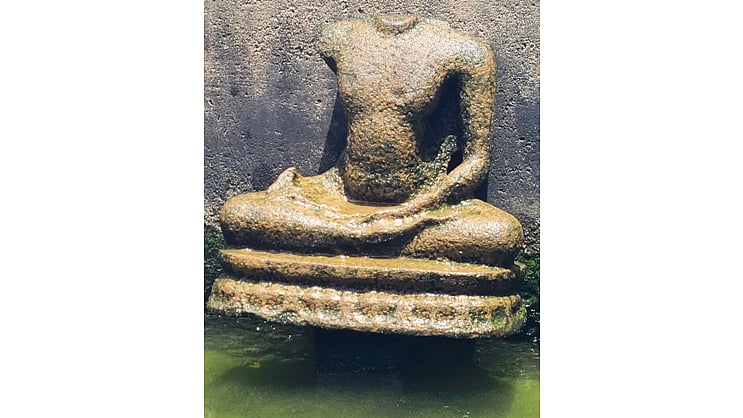
A headless Buddha statue recovered from one of the ponds of Kadri Sri Manjunatha temple in Mangaluru.
Credit: Special arrangement
Mangaluru: A headless Buddha sculpture lying in one of the ponds of Kadri Sri Manjunatha temple, has been recovered by the team headed by Prof T Murugeshi, a retired Associate Professor in Ancient History and Archaeology, MSRS College, Shirva in Udupi.
A press release stated that the Buddha image was in a discarded state of condition. It was uplifted from the water for study with the permission of the temple administrator.
The seated Buddha idol, dating back to about 4th-6th century AD is about 68 cm in height and 48 cm in width including the prop of the image, is in a meditative posture, and is highly corroded. The head and the right hand of the idol are missing.
The discovery of the Buddha idol has a great importance in South Asian Buddhist studies and Tuluva history as well. The image has close similarities with that of the Buddha image found at Mushira Waddo in Colvale of Goa, now displayed in Fr Heras Institute, located in St Xavier’s College, Mumbai. The Dhyani Buddha image belongs to Mahayana Buddhism.
Kadri was a Buddhist centre up to 10th century AD as revealed by the inscription of Alupa king Kundavarma found on the Lokeshwara image of Kadri temple.
The Mahayana Buddhist were replaced by Vajrayana Buddhist and they were turned out by the Natha cult in the 11th century, Prof T Murugeshi mentioned.
Laterite rock caves
In yet another archaeological explorations conducted in the temple premises, A group of three rock cut caves in laterite above the ground, discovered by the team, above the eastern side of Kadri tanks.
The first one is about 8 feet in height and has a semi circular entrance like a porthole. It has a single square room with a small provision for lamps. The entire structure looks like a Megalithic Dolmen.
The middle and third one have a high plinth and two square entrances with single square rooms. All caves have a sloppy canopy with holes to clear off rainy water. The nature of the caves suggest that they belong to the Mahayana period and give indications about being used for residential purposes.
Prof Murugeshi has meanwhile thanked temple Administrative Officer Arun Kumar.
Shreyas Kolpe, a research scholar from Manipal University and Shreyas, Assistant Lecturer in Ancient History and Archaeology, MSRS College, Shirva, Karthik, a Post graduate student in archaeology from University College, Mangalore and Ravindra Kushwaha a graduate student in archaeology MSRS College Shirva, had assisted in the field work, he added.
Prof T Murugeshi has the commissioner of state archaeology to take steps to protect the archeological discoveries.